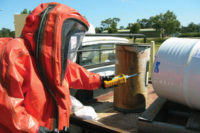
An estimated five million workers in 1.3 million workplaces throughout the U.S. must wear respirators to protect against harmful dusts, fumes, smokes, mists, gases, vapors and other aerosols. At stake are hundreds of lives and the health of thousands of workers who may develop cancer, chronic obstructive pulmonary disease (COPD) silicosis, asbestosis and other forms of pulmonary fibrosis every year.
Work-related respiratory illnesses can be a huge problem for employee productivity, not to mention the related healthcare and workers’ compensation costs incurred by businesses. As an example, NIOSH points to a 2003 statement by the American Thoracic Society (ATS), which estimated that 15 percent of COPD and adult asthma were work-related, with a conservative annual estimated cost of nearly $7 billion in the U.S. alone.
Stiff penalties for noncompliance
Employers are required by law to identify respiratory hazards and to eliminate or reduce risks through process modifications and engineering controls as well as to provide the appropriate personal protective equipment (PPE) to guard against the identified risks. But what happens when employees do not comply with respiratory protection-wearing protocols?Health problems and their associated costs are not the only concerns facing companies whose workers are not properly protected. Consider these recent fines proposed by OSHA for workplaces where workers were not supplied with respirators or did not comply with respirator-wearing protocols:
- $375,000 in fines against a cement and asphalt bagging plant that exposed workers to excess levels of cement dust without adequate ventilation, respiratory protection, PPE and training.
- $321,000 in fines against a bridge and tower painter whose failure to provide appropriate respirators and protective clothing exposed workers to unsafe levels of lead.
- $1.2 million in penalties against a chemical company, part of which was attributed to the company’s failure to provide appropriate PPE, training on PPE and respirator fit-testing.
Improving compliance
In spite of these stiff penalties, compliance with PPE wearing protocols continues to be a problem in the U.S. In fact, a 2008 survey of attendees of the National Safety Council Congress and Expo found that 89 percent observed workers failing to wear PPE when they should have been. And respiratory protection ranked in the top five of OSHA’s Top 10 Most Frequently Cited Standards list for fiscal year 2009.Why are workers reluctant or unable to comply with PPE wearing protocols? Research consistently points to comfort and style as major compliance drivers, making it more important than ever to invest in PPE that workers will want to wear.
There are several features employers may want to consider when evaluating air-purifying respirators to help drive compliance with wear- ing protocols. When making a selection, look for:
- Soft, foam nose pads with bendable bands that conform to the contours of the nose, providing a tight seal without preventing natural breathing.
- Wide, adjustable head straps that hold the respirator in place without digging into the skin or getting tangled in workers’ hair.
- Dual-exhalation valves designed to direct exhaled air down and away from the face to help reduce eyewear fogging and increase easy breathing during use.
- Respirators with highly visible color-coded straps or valves that correspond to the level of protection provided. Color-coding can help employees quickly identify the proper respirator and allow safety managers to determine from a distance if employees are using the correct respirator for a given task.
Training and fit testing
Employers can take other steps as well to drive compliance with respirator-wearing protocols. Employers should educate employees on potential respiratory risks in the work environment so employees are aware of and appreciate the need for respiratory protection. Surprisingly, however, a 2001 NIOSH study found that only 59 percent of private sector employers that required employees to use respirators provided training to help workers understand the use and limitations of their respirators. Only 34 percent had established a written respiratory protection program to guide the manner of respirator use within the establishment.Training is especially important for respiratory hazards that don’t have an acute or immediate health impact as it’s not always as easy to consider health effects that could be years or decades in the making. The challenge with such training is to balance the message to make it strong enough to be motivational yet not exaggerated to the point where it is not believable or in any way adversely affects an individual’s willingness to perform the job.
Training should also include demonstrations and practice time on how to properly don the respirator and determine if it fits correctly. While proper donning of a respirator may feel awkward at first, it will likely become easier with repeated practice, thus driving compliance. Part of the donning process includes a user seal check which should be conducted each time a respirator is worn to help the wearer verify that he or she has properly donned the respirator. Respirator suppliers should provide step-by-step instructions on how to properly don each respirator; many leading suppliers provide these instructions via online videos or other materials.
Fit testing should be conducted prior to initial use of the respirator and then regularly thereafter. This is especially true whenever a different respirator is used and whenever the wearer undergoes changes that could alter facial structure or size, such as facial surgery or significant changes in body weight. The 29 CFR 1910.134 regulation states that fit testing is mandatory for tight-fitting respirators and is a required component of an employer’s written respiratory protection program where respirators are necessary or required by the employer to protect the health of the employee.

